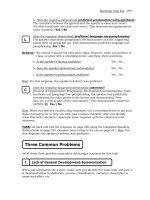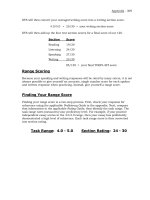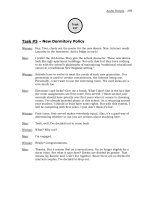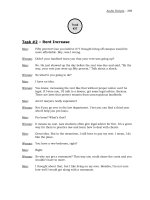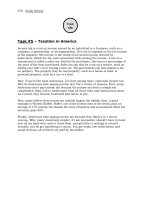Tài liệu Speaking and Writing Strategies for the TOEFL iBT part 24 ppt
Bạn đang xem bản rút gọn của tài liệu. Xem và tải ngay bản đầy đủ của tài liệu tại đây (293.28 KB, 10 trang )
Speaking Task Three - 219
Look at the following map. For this example, the reading announces that university
parking fees are going up 20%. The woman tells the man that the fee increase is a
good idea. That is her opinion, the start of her argument. The man replies by
saying that fee increase is a bad idea. That is his opinion, the start of his counter
argument. Next, the woman will defend her opinion by giving her first reason. The
man will counter the woman’s first reason with a counter reason. The two students
will ping-pong (argue-counter argue) like this until the end.
Notice that these two arguments are really just two verbal independent essays
(G+3TiC=C
) connected by topic.
Does each student always give three supporting illustrations (G+3TiC=C)?
No. Sometimes there will be two supporting illustrations (G+2TiC=C). Be
prepared for three (G+3TiC=C).
As you listen to the two students arguing about the announcement in the reading,
you must take notes and objectively summarize both arguments. However, when
you speak, you will summarize only one argument, either the pro or the con side, not
both.
How will I know which argument to summarize?
After you read the announcement and listen to the dialogue, the prompt
will tell you which argument to summarize.
Next, let’s work through a sample response, step-by-step.
woman: pro fees
pro reason #1
conclusion
con reason #1
conclusion
man: con fees
pro reason #2
con reason #2
pro reason #3
con reason #3
G
TiC
TiC
TiC
C
A
Q
A
Q
220 - Speaking Task Three
When developing and delivering a response for this task, use G+3TiC=C and the
following five steps to demonstrate OPDUL=C
in your response.
First, the narrator will describe the context and give instructions.
As you listen to the narrator, make a note map. Put R for reading at the top. Under
R
, put W for the woman’s argument and M for the man’s argument. Because time
is limited, simply number each body paragraph.
R
M W
G G
1 1
2 2
3 3
C C
Narrator: Shelton University is planning to change its food
service policy. Read the announcement about the change in
policy. You have 45 seconds. Begin reading now.
Developing a Response: Step-by-Step
Make a note map; read and summarize the reading.
Step #1
Speaking Task Three - 221
When the narrator finishes speaking, a countdown clock will appear on your
screen. The clock will countdown (45, 44, 42…). Read the sample passage below.
As you read, summarize the passage under R on your note map. The first point to
summarize is the main topic in the topic sentence. Summarize it objectively
under R
. Next, summarize those points that support the main topic. Those points
are the reasons
why the new policy is being introduced.
main
topic
reasons
When the reading ends, it will be replaced by the dialogue. It will last 60-90
seconds. On the next page, read along as you listen to two students arguing about
the new food policy. As you listen, summarize each argument under M
and W on
your note map.
Announcement from the President
Starting next semester, all food sold at Shelton
University will be organic. This will include all food prepared
and served in the main cafeteria, as well as snacks bought in
vending machines throughout campus. This policy also includes
beverages as well, both hot and cold. When possible, the
university will contract local growers to provide fresh organic
produce. Student meal tickets will continue to be honored. The
university is implementing this policy in order to regulate the
sugar and fat content in student diets. This change in policy
reflects health awareness programs being implemented at
other colleges and universities across the nation.
R
- new policy at Shelton U., next semester, all food organic
- create health awareness
- control sugar and fat in student diets
Listen to the dialogue; summarize both arguments.
Step #2
222 - Speaking Task Three
Man: Hi, Wendy.
Woman: Hey, Tom. Have you heard about the new organic food policy?
Man: Yeah. What a great idea. It’s about time the school did
something to improve the food around here.
Woman: If you ask me, I think the new policy is all wrong.
Man: Why?
Woman: Because organic food is way more expensive. In some cases,
at least fifty per cent more. Add that to labor costs, you know,
money to pay the cafeteria staff, and I’m going to be paying a
lot more for my coffee and the milk I put in it. I hate to think
what a salad will cost. Organic may be cheaper in the future, but
right now it’s for people with money not poor students like me.
Man: But think of all the health benefits. You’ll be eating food that
doesn’t have any chemicals or antibiotics in it. Not only that but
all that good organic food will be lower in fat and calories. I
mean, that’s got to be good, right?
Woman: Don’t be fooled. A hamburger is a hamburger whether the meat
is organic or not. Both will have the same amount of fat and
calories. The only difference is the organic hamburger has no
pesticides or antibiotics in it.
Man: Well, I still think it’s a good idea. By offering organic food, we’ll
be eating a lot better. Even the snacks in the vending machines
will be organic. It’s definitely the wave of the future. Best of all,
we’ll be helping local farmers.
Woman What I don’t like is the university telling us what we can and
can’t eat. Not everybody wants to eat organic, you know. If I
want to eat non organic, that’s my choice. Sorry, but the school
should not be in the health care business.
Narrator: Listen as two students discuss the announcement.
CD
Track
#12
Speaking Task Three - 223
Next, look at both arguments summarized in note form. Note the transitions of
addition (first, next, finally) at the start of each body paragraph (TiC).
Do not summarize the entire reading passage, only the main points. If
your summary of the reading is too long, you will run out of time
summarizing the student argument.
When the 45 seconds are up, the reading passage will leave your
screen. The reading passage will not
return. Therefore, you must
summarize it at this step.
R
- new policy at Shelton U., all food organic next semester
- create health awareness
- control sugar and fat in student diets
M W
G supports policy G against policy
1 first thinks it is a good 1 first organic 50% more
idea expensive
improve university food she is poor and will pay
more
2 next organic means less 2 next organic does not
fat + fewer calories mean fat + calorie free
good for students’ health can get fat eating organic
3 finally students will eat better 3 finally school should not
tell students what to eat
wave of the future; help no choice = no freedom
farmers
C for those reasons C for those reasons
supports policy against policy
Remember!
Remember!
224 - Speaking Task Three
When the dialogue ends, it will leave your screen. You cannot replay it. The
dialogue will be replaced by the prompt. The narrator will read it.
When the narrator stops reading the prompt, a countdown clock will count down
(30, 29, 28…). You will have 30 seconds to prepare your response. Look at your
map and begin to organize your ideas using G+3TiC=C
.
When the countdown clock reaches zero, you will hear a “Beep!” Look at your
note map. Start by summarizing the context in one sentence. The context
introduces the main topic. When speaking, use the present tense, and speak
objectively (He says She says…They say…It says…), for example:
Next, summarize the reading passage. First, identify the new policy (the main
topic) and the reasons
for the new policy.
Next, summarize the woman’s argument.
Do not summarize both arguments. Only summarize the argument
stated in the prompt, in this case, the woman’s argument.
Prompt The woman states her opinion about the new
university policy. Explain her opinion and the
reasons she gives for maintaining that position.
Two students are discussing the new organic food policy at
Shelton University.
Starting next semester, all the food at Shelton
University will be organic. The university says that organic
food will be healthier for the students and that other schools
are making the same changes.
Speak (60 seconds).
Step #5
Warning!!
Read the prompt.
Step #3
Prepare your response (30 seconds).
Step #4
Speaking Task Three - 225
Mapped out, the structure of the woman’s response looks like this.
context
summary
of the
reading
summary
of the
woman’s
argument
Two students are discussing the new organic food policy at
Shelton University.
Starting next semester, all the food at Shelton University will
be organic. The university says that organic food will be
healthier for the students and that other schools are making
the same changes.
The woman argues that the new policy is a bad idea.
First, she says that organic food is fifty percent more expensive
than regular food. That means she will have to pay more for
her coffee and salads. She says organic food is for rich people,
not poor students like her.
Next, she says that organic food does not mean healthier food.
For example, she says a regular hamburger and an organic
hamburger have the same calories and fat. Organic food, she
says, is not healthier.
Finally, she doesn’t want the university telling her what she
should eat. The university is taking away her freedom to
choose. If she wants to eat regular food, that is her choice.
For those reasons, the woman is against the new food policy.
Words: 174
The woman argues that the new policy is a bad idea.
First, she says that organic food is fifty percent more expensive
than regular food. That means she will have to pay more for
her coffee and salads. She says organic food is for rich people,
not poor students like her.
Next, she says that organic food does not mean healthy food.
For example, she says a regular hamburger and an organic
hamburger have the same calories and fat. Organic food, she
says, is not healthier.
Finally, she doesn’t want the university telling her what she
should eat. The university is taking away her freedom to
choose. If she wants to eat regular food, that is her choice.
For those reasons, the woman is against the new food policy.
226 - Speaking Task Three
Mapped out, you can see how G+3TiC=C gives the speaking raters what they are
trained to listen for: a coherent integrated spoken response that demonstrates
OPDUL=C
. Note: Transitions (T) are in bold, the supporting illustration (i) in italics,
the introduction, opinion (G) and the conclusions (C) underlined
.
G = general = Two students are discussing the new organic
food policy at Shelton University.
Starting next semester, all the food at Shelton
University will be organic. The university says that
organic food will be healthier for the students and
that other schools are making the same changes.
general = The woman argues that the new policy is a bad
idea.
TiC = specific = First, she says that organic food is fifty percent
more expensive than regular food. That means she
will have to pay more for her coffee and salads. She
says organic food is for rich people, not poor
students like her.
TiC = specific = Next, she says that organic food does not mean
healthier food. For example, she says a regular
hamburger and an organic hamburger have the same
calories and fat. Organic food, she says, is not
healthier.
TiC = specific = Finally, she doesn’t want the university telling her
what she should eat. The university is taking away
her freedom to choose. If she wants to eat regular
food, that is her choice.
C = general = For those reasons, the woman is against the new
food policy.
Do I have to speak for all 60 seconds? Is there some rule?
No. There is no rule that says you must speak continuously for 60
seconds.
You are demonstrating OPDUL=C. If you have demonstrated
OPDUL=C
in 50 seconds, great, just sit there and wait for the next
task. While waiting, make a note map for speaking task four.
Remember!
Q
A
Speaking Task Three - 227
Using G+3TiC=C and speaking at a normal pace, you should be able to deliver a
response that demonstrates OPDUL=C
in 60 seconds. The following map illustrates
approximate time divisions for each step of this task.
You are reading this example. On test day, you will pause and
hesitate when you speak and thus use more time.
G 5 seconds Two students are discussing the new organic
food policy at Shelton University.
10 seconds Starting next semester, all the food at Shelton
University will be organic. The university says
that organic food will be healthier for the
students and that other schools are making the
same changes
40 seconds The woman argues that the new policy is a
bad idea.
TiC First, she says that organic food is fifty
percent more expensive than regular food. That
means she will have to pay more for her coffee
and salads. She says organic food is for rich
people, not poor students like her.
TiC Next, she says that organic food does not mean
healthier food. For example, she says a regular
hamburger and an organic hamburger have the
same calories and fat. Organic food, she says, is
not healthier.
TiC Finally, she doesn’t want the university telling
her what she should eat. The university is
taking away her freedom to choose. If she wants
to eat regular food, that is her choice.
C 5 seconds For those reasons, the woman is against the new
food policy.
How Long Should My Response Be?
Remember!
228 - Speaking Task Three
Next, check the sample response for OPDUL=C using the proficiency checklist.
Does the response demonstrate organization?
The speaker uses deduction as a method of organizing her argument. This
demonstrates organization. Yes √ No
Does the response demonstrate progression?
Because the speaker is using deduction, the response progresses from
general to specific. This demonstrates progression. Yes √ No _
a. Does the introduction demonstrate development-summarization?
The speaker has summarized the main points in the reading and the main
points in the woman’s argument with no points left out. This demonstrates
introduction development-summarization. Yes √ No _
b. Does the body demonstrate development-summarization?
The speaker has summarized the main points (3TiC) in the woman’s argument
with no points left out. This demonstrates body development-summarization.
Yes √ No _
c. Does the conclusion demonstrate development-summarization?
The speaker restates the woman’s opinion in the conclusion. This demonstrates
conclusion development-summarization. Yes √ No _
a. Does the response demonstrate topical unity-synthesis?
The speaker focuses on the new policy and why the woman argues against it.
There are no topical digressions. This demonstrates topical unity-synthesis.
Yes
√ No _
b. Does the response demonstrate grammatical unity-synthesis?
The transitions of addition are correct. The connection between the reading
summary and the woman’s argument is also clear. This demonstrate
grammatical unity-synthesis. Yes √ No _
Does the response demonstrate proficient language use-paraphrasing?
The speaker objectively paraphrases the main points in the reading and
the main points in the woman’s argument. There are no errors in syntax.
This demonstrates proficient language-use paraphrasing. Yes √ No _
Delivery: We cannot evaluate the next three steps. However, when you practice in
class, or alone with a recording device, ask these three questions.
a. Is the speaker’s fluency proficient? Yes _ No _
b. Does the speaker demonstrate automaticity? Yes _ No _
c. Is the speaker’s pronunciation proficient? Yes _ No _
Note: For this response, the speaker’s delivery was proficient.
O
P
D
U
L
